| |
Our Garden Services
All the images shown on this website are our own design and work.
Paving
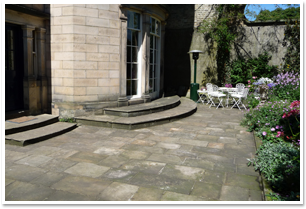 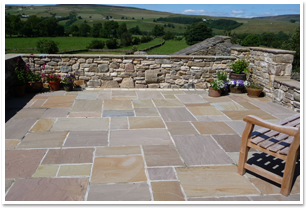
Patios and terraces are a great extension to any home and will greatly increase the use of the garden, often providing an essential link between indoor and outdoor areas. They can give easy access for children, wheelchairs, prams and older people. A level area for relaxing, entertaining, or viewing the garden, all you need is the sun! All the paving that we install is laid on a wet mix and the joints are pointed by hand. This gives a very professional finish and means that no moss or weeds will grow through the cracks, making it easy to maintain. - Reclaimed paving of a good quality is getting difficult to source. This type of paving suits older property, as shown in the picture top left. The customer wanted some paving re-laid and the area of paving extending.
- Indian paving is natural stone and comes in a variety of different finishes and colours as shown in picture top right. The supplier that we use states that all their Indian products are ethically sourced. Indian stone is much cheaper than locally quarried stone.
- Locally quarried stone comes in a variety of types and colours, we do not use it very often as it is expensive.
- Man made paving can also appear expensive now with the importation of Indian stone, but customers may require a non-slip type of paving, or need to match some paving that is already laid.
If you decide to pave, try to choose materials that are suited to your surroundings and budget. Large areas of paving can be broken up and given more visual interest by incorporating different materials such as cobbles, setts, gravel and even circle kits. » Click here to see more images of Paving
|
Paths
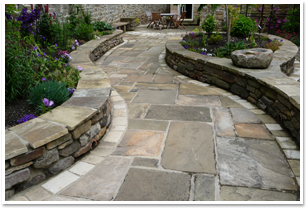 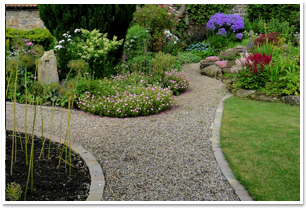
Paths are the arteries of a garden, leading you from one area to another, forming the lines of communication between house and garden. Paths can be manipulated in their width, thickness, colour, texture, directions and shape. They can give access to views, focal points, places for gathering or solitude. To have low maintenance paths, it is important to follow the correct procedure, we always dig out the path, use a good depth of compacted small hardcore to make a solid base, and this also acts as a good deterrent to stop any weeds from growing. - Paving is the most permanent feature, natural stone the most prestigious and will always look better with age as shown in picture top left.
- River gravel is larger than pea gravel, easier to walk on but not ideal for pushing wheelbarrows etc about on. It is cheap and can help improve security as you can tell when someone is approaching the house.
- Pea gravel is smaller than river gravel, but ideal for a traditional cottage garden path. When using pea gravel it will need to be edged to contain it in the path area as shown in picture top right.
- Limestone chippings are much more angular than the gravels, very hardwearing and they will lock together making them an ideal choice for heavy use footpaths or drives.
Edging paths will stop lateral spread and ease maintenance, we use either stone setts, bricks, cobbles, or traditional edging. The edging can be laid at the same level as the lawn allowing the mower to go over it eliminating the need to edge or strim as shown in picture top right. » Click here to see more images of Paths
|
Steps
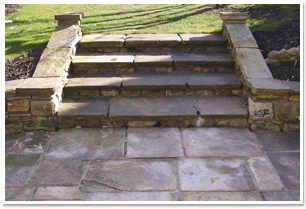 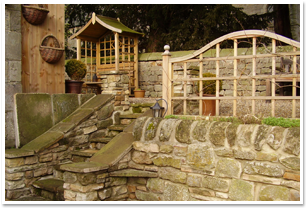
Steps are possibly the most important construction element in any garden, and can be a beautiful focal point as shown in picture top left. Steps can act as an inviting conduit, and a way of negotiating slopes and changes in levels quickly and safely. Wherever you have steps, walls will usually be built too as shown in picture top right. The soil on each side will need to be retained to stop the bank from collapsing. Risers and treads need to be built very carefully to make good use of the space available, and to ensure they are safe to use. Badly designed steps can be extremely dangerous. Steps can be built from stone, paving, timber, and sleepers. By using railway sleepers as a riser, infilled with gravel behind for treads, this will help keep material and labour costs down. Plants can also help soften steps by allowing them to spill over the edges of steps and retaining walls. To increase the use of steps and retaining walls they can be used as seating areas, just add a few cushions! » Click here to see more images of Steps
|
Drives
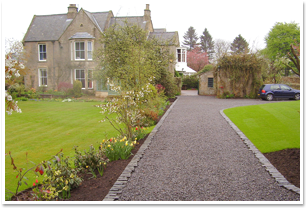 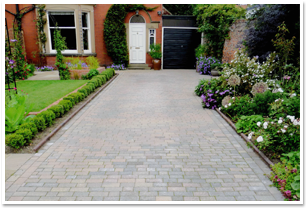
Drives often form the first impression and can create the perfect approach to your home. Careful consideration of the use of the drive needs to be given and if the space is available, plenty of room for multiple cars and manoeuvring needs to be allowed. - Paving a drive is a permanent finish which is low maintenance if correctly laid and carefully pointed by hand with a wet mix of mortar.
- Whin or limestone chippings are extremely hard wearing, ideal for drives on the flat or slopes. As they are angular they knit together better than gravel and compact well to make a traditional looking drive as shown in picture top left. They are also good for security as you can hear when someone or something is on the drive.
- Gravel looks pretty and traditional, but it will move around more than whin or limestone chippings as it is more rounded in shape. Again, as with chippings the use of gravel can improve security.
- Man made block paving or stone setts come in a vast array of colours and materials as shown in picture top right, they can match any type of house but can be fairly high maintenance if moss or weeds are allowed to grow.
- Tarmac can make a drive look a bit like a car park and slightly boring, but it is easily maintained.
Edging a drive with setts to contain whatever material is used, can give a more interesting finish and will allow easier maintenance of grass if it is adjacent to the drive. » Click here to see more images of Drives
|
Walls
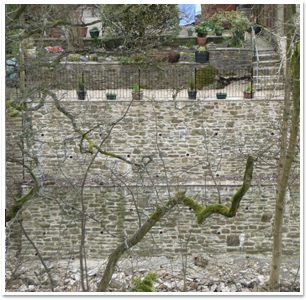 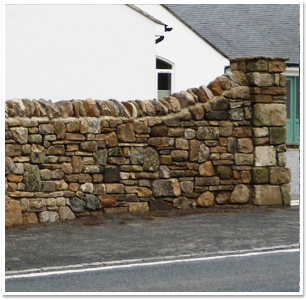
Walls can be used for defining boundaries, visual and acoustic screening. They can be built from stone, brick or concrete. A new wall should be thought of as an investment, something that will enhance the property and improve its value. A good well built wall will out-live a timber fence many times over, and last for generations. - Drystone walling is an ancient craft dating back hundreds of years, Sylvia’s Father did this for most of his working life. Drystone walls are used all around Teesdale, giving a distinctive look to the fields and fells of the Northern Pennines. They are built using only stone and no mortar, and can make a strong and positive contribution to your garden, working particularly well in rural settings.
- Wet stone walling allows walls to be built which are higher and more vertical than drystone walls would allow as shown in picture top left. Stone can be cut and laid in horizontal courses or random stone can be used to give a more informal and interesting look to the wall, as shown in picture top right.
- Brick walls were very fashionable in the 18th and 19th centuries, they are used more in towns to match brick built houses. Reclaimed bricks can also be used to match old brick built houses or cottages.
- Concrete and rendered block work are cheap to build, and are usually covered in a smooth cement-based render and then painted. They can give a very clean and modern feel to a wall and are excellent when used in contemporary gardens.
Coping on walls can be stone, brick or concrete, serving to protect the wall from water and frost, and finishing off the wall. Careful consideration needs to be used before deciding which product to use, but again it often depends on the house and trying to be sympathetic with the surrounding area. » Click here to see more images of Walls
|
Raised Beds
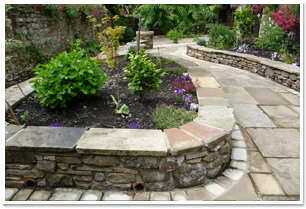 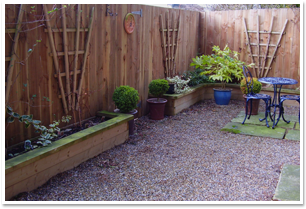
Raised beds are becoming extremely popular, they can be used for planting, vegetable beds and children’s planting areas, etc. They are very good if you need to improve the soil, or need a certain type of soil to grow specific plants. - Stone raised beds look very traditional as shown in picture top left. They are more expensive to build but are a permanent addition to your garden, and with age will look better.
- Timber raised beds as shown in picture top right are quicker and cheaper to build, the timber is tanalised and has a life expectancy of at least fifteen years, but it will not last as long as stone.
- Sleepers can give a more robust feel to your raised bed. New sleepers are great for raised beds and they can be built to a height so that you can use them as extra seating. Old sleepers look good, are interesting to look at but not suitable for sitting on as they often can have patches of exposed tar etc.
Raised beds give the gardener easier access to the soil, which can be useful for the disabled, children, older people and even those of us who don’t want to bend so far! » Click here to see more images of Raised Beds
|
Turfing
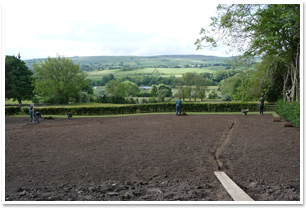 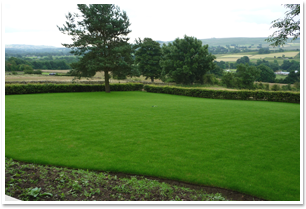
Turfing is a relatively cheap and quick way of transforming an area of garden as shown in the pictures above. The ground would often be treated with weed killer, cleared of stones etc, leveled, gently compacted and then the turf would be laid. In a couple of weeks the grass will have rooted and it can then be used. Edging a lawn can ease maintenance, usually we would use stone setts which can be laid at the same level as the lawn allowing the mower to go over it eliminating the need to edge or strim. » Click here to see more images of Turfing
|
Fences
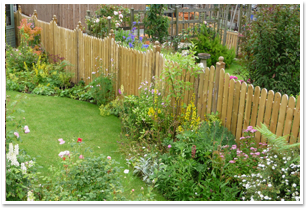 
Fences define boundaries and give the garden structure, shape and proportion. Fences can give quite a different feel to a garden, they can range from been very sturdy and functional, to a picket fence which will give the garden a cottage feel. The design of the fence should be influenced by the local landscape. Our fences are all made on the job and will fit perfectly. Each post, rail and board used will be tanalised, these have been pressure treated to protect the timber and have a life expectancy of at least fifteen years. It is not necessary to treat the wood. - A boarded fence built correctly is a very solid structure, it can be close boarded giving privacy and shelter, alternatively the boards can be gapped which is useful in very exposed areas, allowing some wind to pass through.
- A picket fence is ideal in a country cottage setting as shown in picture top left, the gapping can vary as required according to taste.
- A post and rail fence is good in a rural setting, for enclosing a large area of garden or field, it allows you to see beyond the fence but still acts as a boundary as shown in picture top right.
- Trellis is not as substantial as any of the above fences, but can be used as screening and is a good support for climbing plants.
- Park railings made from metal act as a boundary, but allow you to see beyond it. It can be made to curve beautifully to suit a curving site.
» Click here to see more images of Fences
|
Decking
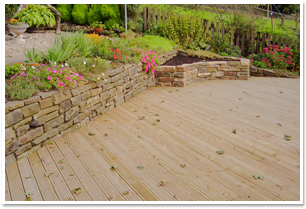 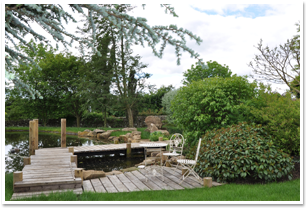
This is something we are not asked to do very often, probably because of the climate in Teesdale! But it is extremely versatile, with designs that can be tailor made to suit all sizes of gardens. Interesting ways of using decking could be around a tree or as a viewing platform. Decking is simply a wooden platform that can be built at ground level or on multi levels. The platform is composed of a wooden supporting framework, with a timber surface made from hard or soft wood decking board. These have been pressure treated to protect the timber and have a life expectancy of at least fifteen years. The board may be laid straight or at an angle. To break up the area, planters can be built in stone or wood as shown in picture top left. - Decking can be used around a tree and may include some seating.
- Children’s play area which could incorporate storage for outside toys.
- Viewing area which may be elevated using decking to let you see a particular view.
- Walkway over very wet or boggy area of garden.
- Jetty over a pond, this gives an added dimension to the pond and allows access out over the water as shown in picture top right.
» Click here to see more images of Decking
|
Ponds
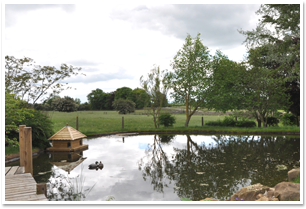 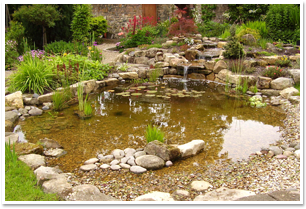
A pond is a beautiful addition to any garden, adding colour, light and movement. The reflective surface of the water will add light, plants will add colour and the pond will encourage amphibians, insects and birds into the garden. - A natural pond if designed correctly can be very valuable to wildlife and can add an air of tranquillity to your garden as shown in picture top left.
- Small traditional garden pond shown top right has a bog garden which acts as an overflow for excess water, water loving plants can be grown in this area as shown in picture top right. The pebble shore line allows easy access to the water for amphibians to lay their eggs and the owners were delighted when they found that the great crested newt was using the pond.
- Formal pools are usually built with stone, brick, timber or poured concrete. They are usually symmetrical in shape, have hard edges and can be either sunk into the ground, built above it or a combination of both. Fountains, ornamental statues and other man made objects may add to the formality of your pond.
Other additions, such as bridges, jetties etc can be added to your pond, but we always try to make the pond look like it belongs in its surroundings. » Click here to see more images of Ponds
|
Garden Features
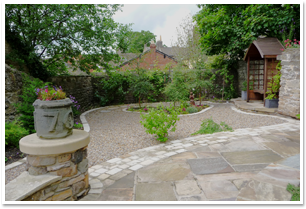 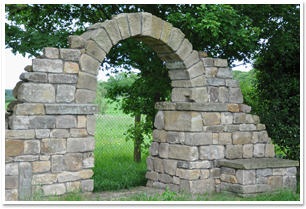
A garden feature is something that will draw the eye to it and be a unique focal and talking point in the garden. It could range from an arbour or pergola, to a working hand pump used to water the garden from a well, or even a ruined stone arch, the choice is yours. - Pergolas provide height and interest in the garden. They can be bought in kit form or constructed on site. An ideal frame to grow climbing plants that will provide a soft screen from neighbours and a sun screen that filters light with its lattice like canopy. They can be used to form tunnels, links to other parts of the garden and over circular paved or decked areas as shown in the picture.
- Arbours can add height to a garden, they can be bought in kit form or constructed on site. They are ideal as a sheltered seating area either offering shade from the sun or protection from the wind as shown in picture top left.
- Arches can add height to walls or fences, and draw attention to an entrance, frame a view or act as a link to divided areas of the garden.
- A ruined arch can be built, the client had an arch laid in the garden unused and wanted to make a focal point in the garden as seen in picture top right.
- A milk stand built from stone to match the house serves a double purpose in that it shows the house name, but it is also hiding an ugly industrial feature.
- Stone table made from a reclaimed flag can serve as a seat, table or even plant stand.
- Stone bench made from bull nosed paving flags that came from a local disused railway station, blends in well with the old stone wall and looks like it has been there forever.
- A water pump shown in one of the further pictures which can be seen by clicking the link below, was installed when a disused well was discovered, the water pump was fitted and the client was delighted as he now uses it to water his garden, a feature and functional too.
Whatever garden feature you decide to use, try to make sure that it compliments and is in harmony with its surroundings. » Click here to see more images of Garden Features
|
Childrens Play Area
An area in the garden just for the children, somewhere they can do what they want (within reason!) and make as much mess as they like. - Commercial play area in Darlington that we landscaped shown in the picture to the right.
- Raised beds strictly for the children, so they can plant and watch things grow. We have built these for a local nursery and school and the children love them.
- Sand pits built from wood, with a cover made of wood to keep out any unwanted visitors.
- Tree house with room to play and storage for toys, this need not be high up in a tree, it could just be decking built around a tree.
- Secluded area at the bottom of the garden, somewhere for a sand pit, a hole in which to dig, raised beds to plant in, and a little play house to play in and hide away all those toys.
|
Low Maintenance Gardens
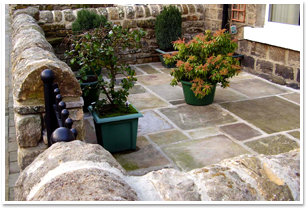 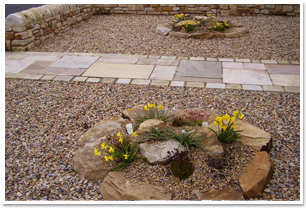
Nowadays we don’t seem to have the spare time we would like to look after the garden or we are getting older and find the garden too difficult to deal with. More people want low maintenance gardens. - Paving is very low maintenance, a few pots added to the area can make it look colourful and well looked after as shown in picture top left.
- Gravel is cheaper than paving and if laid correctly on a weed-proof membrane, with compacted hardcore beneath, weeding should not be a problem. Add a little rockery or a few pots to add some interest and you can sit back and enjoy the garden as shown in picture top right.
» Click here to see more images of Low Maintenance Gardens
|
|
|

